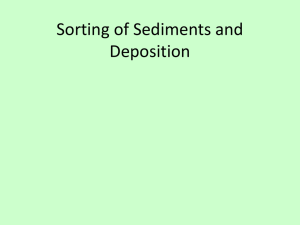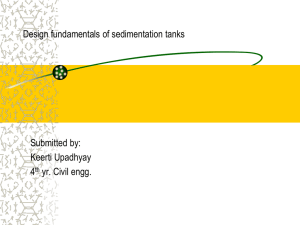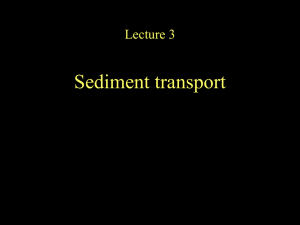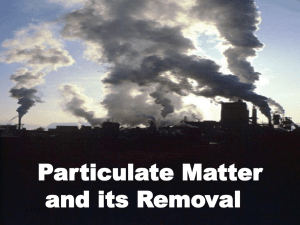SEDIMENTATION
advertisement
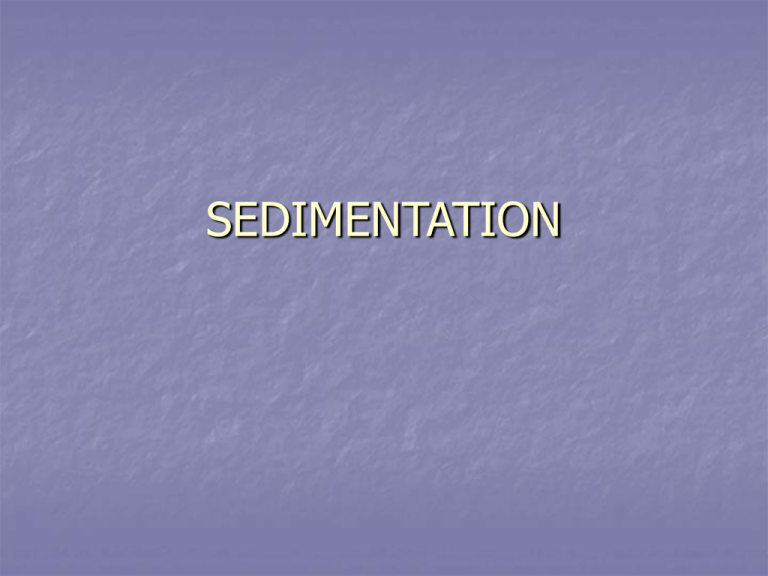
SEDIMENTATION INTRODUCTION Sedimentation, or clarification, is the process of letting suspended material settle by gravity. Suspended material may be particles, such as clay or silts, originally present in the source water. More commonly, suspended material or floc is created from material in the water and the chemical used in coagulation or in other treatment processes, such as lime softening. INTRODUCTION Sedimentation is accomplished by decreasing the velocity of the water being treated to a pointbelow which the particles will no longer remain in suspension. When the velocity no longer supports the transport of the particles, gravity will remove them from the flow. FACTORS AFFECTING SEDIMENTATION PARTICLE SIZE The size and type of particles to be removed have a significant effect on the operation of the sedimentation tank. The shape of the particle also affects its settling characteristics. All particles tend to have a slight electrical charge. FACTORS AFFECTING SEDIMENTATION WATER TEMPERATURE When the temperature decreases, the rate of settling becomes slower. The result is that as the water cools, the detention time in the sedimentation tanks must increase. In most cases temperature does not have a significant effect on treatment. A water treatment plant has the highest flow demand in the summer when the temperatures are the highest and the settling rates the best. When the water is colder, the flow in the plant is at its lowest and, in most cases, the detention time in the plant is increased so the floc has time to settle out in the sedimentation basins. FACTORS AFFECTING SEDIMENTATION CURRENTS Several types of water currents may occur in the sedimentation basin: • Density currents caused by the weight of the solids in the tank, the concentration of solids and temperature of the water in the tank. • Eddy currents produced by the flow of the water coming into the tank and leaving the tank. The currents can be beneficial in that they promote flocculation of the particles. However, watercurrents also tend to distribute the floc unevenly throughout the tank; as a result, it does not settle out at an even rate. Some of the water current problems can be reduced by the proper design of the tank. Installation of baffles helps prevent currents from short circuiting the tank. SEDIMENTATION BASIN ZONES Inlet zone The inlet or influent zone should provide a smooth transition from the flocculation zone and should distribute the flow uniformly across the inlet to the tank. The normal design includes baffles that gently spread the flow across the total inlet of the tank and prevent short circuiting in the tank. The baffle could include a wall across the inlet, perforated with holes across the width of the tank. SEDIMENTATION BASIN ZONES SEDIMENTATION BASIN ZONES Settling Zone The settling zone is the largest portion of the sedimentation basin. This zone provides the calm area necessary for the suspended particles to settle. Sludge Zone The sludge zone, located at the bottom of the tank, provides a storage area for the sludge before it is removed for additional treatment or disposal. SEDIMENTATION BASIN ZONES Basin inlets should be designed to minimize high flow velocities near the bottom of the tank. If high flow velocities are allowed to enter the sludge zone, the sludge could be swept up and out of the tank. Sludge is removed for further treatment from the sludge zone by scraper or vacuum devices which move along the bottom. SEDIMENTATION BASIN ZONES Outlet Zone The basin outlet zone or launder should provide a smooth transition from the sedimentation zone to the outlet from the tank. This area of the tank also controls the depth of water in the basin. Weirs set at the end of the tank control the overflow rate and prevent the solids from rising to the weirs and leaving the tank before they settle out. PARTICLE REMOVAL In sedimentation, particles are falling from rest under the force of gravity. Therefore in sedimentation, eqn. (1.1) takes the familiar form of Stokes' Law: vm = D2g(p - f )/18µ PARTICLE REMOVAL Stoke's Law applies only in streamline flow and strictly only to spherical particles. In the case of spheres the criterion for streamline flow is that (Re) = 2, and many practical cases occur in the region of streamline flow, or at least where streamline flow is a reasonable approximation PARTICLE REMOVAL Stokes' Law applies only to cases in which settling is free, that is where the motion of one particle is unaffected by the motion of other particles. Where particles are in concentrated suspensions, an appreciable upward motion of the fluid accompanies the motion of particles downward. PARTICLE REMOVAL So the particles interfere with the flow patterns round one another as they fall. Stokes' Law predicts velocities proportional to the square of the particle diameters. In concentrated suspensions, it is found that all particles appear to settle at a uniform velocity once a sufficiently high level of concentration has been reached. Where the size range of the particles is not much greater than 10:1, all the particles tend to settle at the same rate. PARTICLE REMOVAL This rate lies between the rates that would be expected from Stokes' Law for the largest and for the smallest particles. In practical cases, in which Stoke's Law or simple extensions of it cannot be applied, probably the only satisfactory method of obtaining settling rates is by experiment. Gravitational Sedimentation of Particles in a Liquid Solids will settle in a liquid whose density is less than their own. At low concentration, Stokes' Law will apply but in many practical instances the concentrations are too high. Gravitational Sedimentation of Particles in a Liquid In a cylinder in which a uniform suspension is allowed to settle, various quite well-defined zones appear as the settling proceeds. At the top is a zone of clear liquid. Below this is a zone of more or less constant composition, constant because of the uniform settling velocity of all sizes of particles. At the bottom of the cylinder is a zone of sediment, with the larger particles lower down. If the size range of the particles is wide, the zone of constant composition near the top will not occur and an extended zone of variable composition will replace it. Gravitational Sedimentation of Particles in a Liquid In a continuous thickener, with settling proceeding as the material flows through, and in which clarified liquid is being taken from the top and sludge from the bottom, these same zones occur. The minimum area necessary for a continuous thickener can be calculated by equating the rate of sedimentation in a particular zone to the counter-flow velocity of the rising fluid. In this case we have: Gravitational Sedimentation of Particles in a Liquid vu = (F - L)(dw/dt)/A where vu is the upward velocity of the flow of the liquid, F is the mass ratio of liquid to solid in the feed, L is the mass ratio of liquid to solid in the underflow liquid, dw/dt is the mass rate of feed of the solids, r is the density of the liquid and A is the settling area in the tank. Gravitational Sedimentation of Particles in a Liquid If the settling velocity of the particles is v, then vu = v and, therefore: A = (F - L)(dw/dt)/v The same analysis applies to particles (droplets) of an immiscible liquid as to solid particles. Motion between particles and fluid is relative, and some particles may in fact rise. DISCRETE (TYPE I) SETTLING DISCRETE (TYPE I) SETTLING DISCRETE (TYPE I) SETTLING DISCRETE (TYPE I) SETTLING DISCRETE (TYPE I) SETTLING DISCRETE (TYPE I) SETTLING DISCRETE (TYPE I) SETTLING DISCRETE (TYPE I) SETTLING DISCRETE (TYPE I) SETTLING DISCRETE (TYPE I) SETTLING DISCRETE (TYPE I) SETTLING DISCRETE (TYPE I) SETTLING DISCRETE (TYPE I) SETTLING DISCRETE (TYPE I) SETTLING DISCRETE (TYPE I) SETTLING DISCRETE (TYPE I) SETTLING DISCRETE (TYPE I) SETTLING DISCRETE (TYPE I) SETTLING DISCRETE (TYPE I) SETTLING DISCRETE (TYPE I) SETTLING DISCRETE (TYPE I) SETTLING DISCRETE (TYPE I) SETTLING DISCRETE (TYPE I) SETTLING DISCRETE (TYPE I) SETTLING FLOCCULATED (TYPE II) SETTLING FLOCCULATED (TYPE II) SETTLING FLOCCULATED (TYPE II) SETTLING FLOCCULATED (TYPE II) SETTLING FLOCCULATED (TYPE II) SETTLING FLOCCULATED (TYPE II) SETTLING FLOCCULATED (TYPE II) SETTLING FLOCCULATED (TYPE II) SETTLING ZONE (TYPE III) SETTLING ZONE (TYPE III) SETTLING The zone (or hindered) settling, which occurs when the particles do not settle independently, is also studied by batch tests. In this case an effluent that is initially uniform in solids concentration, if allowed to settle, will do so in zones, the first of which is that of clarified water (1), below is the interfacial zone (2) in which the solids concentration is considered uniform. ZONE (TYPE III) SETTLING In the bottom a compact sludge develops in the so called compaction zone (4). Between (2) and (4), a transition zone (3) generally exists. As time proceeds, the clarified effluent and compaction zones will increase in size while the two intermediates will eventually disappear. ZONE (TYPE III) SETTLING Diagram of a zone settling process ZONE (TYPE III) SETTLING In some cases, further compaction may occur. The actual configuration of a sedimentation tank can be either rectangular or circular. Rectangular settling tanks are generally used when several tanks are required and there is space constraint, since they occupy less space than several circular tanks. COMPRESSION (TYPE IV) SETTLING SELECTION OF BASIN Rectangular Basins Rectangular basins are commonly found in largescale water treatment plants. Rectangular tanksare popular as they tend to have: • High tolerance to shock overload • Predictable performance • Cost effectiveness due to lower construction cost • Lower maintenance • Minimal short circuiting RECTANGULAR BASINS RECTANGULAR BASINS RECTANGULAR BASINS SELECTION OF BASIN Circular and Square Basins Circular basins are frequently referred to as clarifiers. These basins share some of the performance advantages of the rectangular basins, but are generally more prone to short circuiting and particle removal problems. For square tanks the design engineer must be certain that some type of sludge removal equipment for the corners is installed. CIRCULAR BASINS CIRCULAR BASINS CIRCULAR BASINS SELECTION OF BASIN HIGH RATE SETTLERS High rate tube settlers are designed to improve the characteristics of the rectangular basin and to increase flow through the tank. The tube settlers consist of a series of tubes that are installed at a 60 degree angle to the surface of the tank. The flow is directed up through the settlers. Particle have a tendency to flow at a angle different than the water and to contact the tube at some point before reaching the top of the tube. After particles have been removed from the flow and collected on the tubes, they tend to slide down the tube and back into the sludge zone. HIGH RATE SETTLERS HIGH RATE SETTLERS HIGH RATE SETTLERS HIGH RATE SETTLERS HIGH RATE SETTLERS SELECTION OF BASIN SOLIDS CONTACT UNITS A solids contact unit combines the coagulation, flocculation, and sedimentation basin in one unit. These units are also called upflow clarifiers or sludge-blanket clarifiers. The solids contact unit is used primarily in the lime-soda ash process to settle out the floc formed during water softening. Flow is usually in an upward direction through a sludge blanket or slurry of flocculated suspended solids. SOLID CONTACT UNITS
